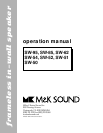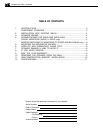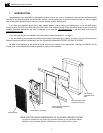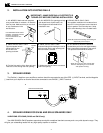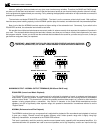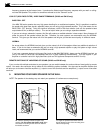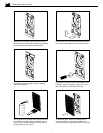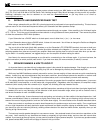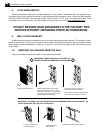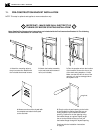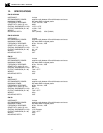
8
FRAMELESS IN-WALL SPEAKER
If you have any questions about your speaker system, please contact your M&K dealer or call the M&K factory directly at
(818) 701-7010, from 8:30 AM to 5:00 PM Pacific Time, Monday through Friday. We will be happy to help you with any question.
Additional information may also be obtained on our web site www
.mksound.com or you may send us an e-mail to
suppor
t@mksound.com.
6. SATELLITE AND SUBWOOFER PHASE TEST
When using a subwoofer with your SW-150, a phasing test must be performed to insure good bass blending. This test insures
optimum sound in the critical bass frequencies where your Subwoofer and Main speakers overlap.
Play a familiar CD or DVD with steady, consistent bass content through your system. Listen carefully to the "mid-bass" region
of 75 - 125 Hz. This is the part of the spectrum where electric or string basses and drums predominate. Then reverse the phase
of either the subwoofer or BOTH Main speakers.
If your Subwoofer has a PHASE switch on its back panel, move it either from (+) to (—) or vice versa.
If your Subwoofer does not have a PHASE switch, it takes a bit more work. You will have to change the Positive and Negative
speaker inputs on the back of BOTH Main speakers.
You can do this at the back of both Main speakers, or at the Subwoofer's TO SPEAKERS terminals, but never at both loca-
tions. The lead that was on the Positive (+) terminal should be switched to the Negative (—) terminal, and vice versa. When
switching speaker wires, take care to protect your amplifier. Make sure that the wires do not touch each other when you are mak-
ing the switch. As a safety measure, we suggest that you turn the amplifier off before making the switch.
Now listen to the same musical passage as you did earlier, concentrating on the mid-bass region. If you hear less bass, the
original connection (or switch position) was correct. If you hear more bass, the new connection (or switch) is correct.
7. SPEAKER DAMAGE & HOW TO AVOID IT
An important factor to consider with any loudspeaker system is the potential for speaker damage. Even though your surround
speakers have extremely high power handling ability, they still can be damaged by relatively low powered amplifiers.
While very few M&K Satellites are actually returned for service, the vast majority of those returned are not for manufacturing
defects. Instead, they are returned because they have been overdriven, almost always because the amplifier or receiver used
was driven into clipping distortion. This damage is considered abuse, and is not necessarily covered under warranty.
This clipping distortion occurs when the demands of the music are greater than the amplifier's available power. It can occur
at 20 watts with a small amplifier, or at 400 watts with a large amplifier. Regardless, when this happens, the amplifier's output
waveform (which usually looks like a smooth arc) is "clipped" off, exhibiting a flat top instead of the arc.
This flat top contains multiples of the original amplified frequencies, sometimes at higher levels than the original signal itself.
For tweeters, this can be very damaging, as this distortion is well above the audible range, where you will be unable to hear it,
and where the tweeter is more vulnerable to damage.
When an amplifier clips, its sound becomes harsh and grating, and a break-up is often audible in the bass frequencies. It will
become uncomfortable to listen to, compared to a slightly lower volume level. When you are listening at high volume levels, be
aware of the onset of clipping distortion, and turn the volume down slightly if the sound takes on the character described above.
When tone controls or equalizers are used to boost frequencies, the problem occurs much more rapidly. Even a small boost
of low or high frequencies can easily double the power requirement and lead to amplifier clipping at moderate levels. Therefore,
you should use your tone controls judiciously, avoiding extreme boosts of the bass and treble controls, especially when you are
listening at high volume levels.
The best way to avoid speaker damage is to use common sense. Use moderate boosts of tone controls or equalizers, at the
very most. Listen carefully for any harshness and break-up, especially at high volume levels, and turn down the volume when
needed. If you cannot get enough volume, you may need to consider a higher-powered amplifier. If you have any questions about
this, please contact M&K, and we will be happy to discuss it with you further.



